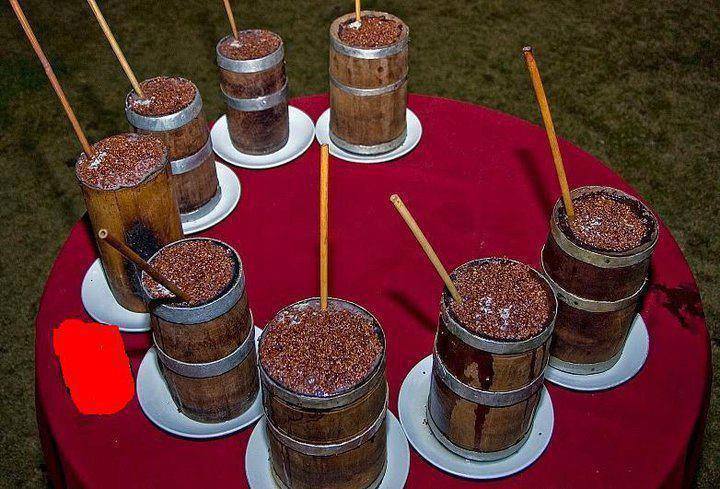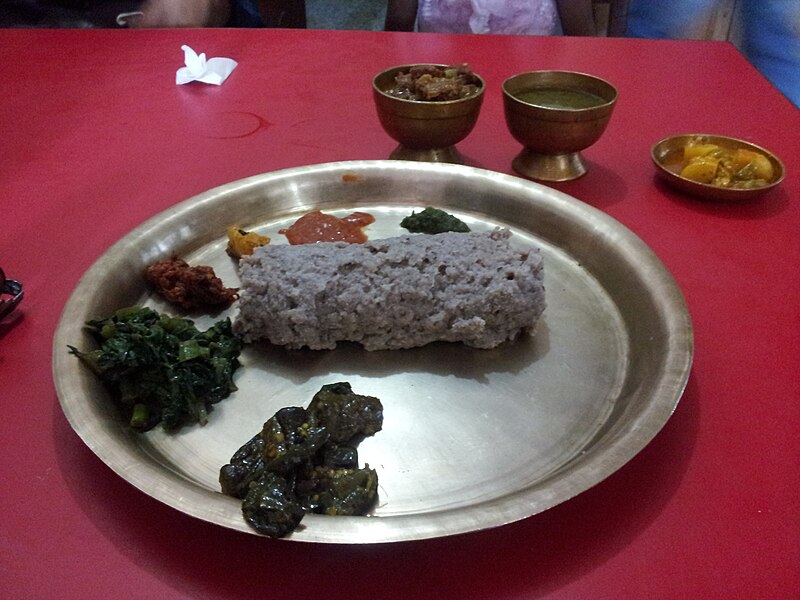Nepali cuisine is a vibrant mix of flavors and textures, influenced by its geography and cultural diversity. From spicy curries to sweet desserts, Nepali food offers a range of tastes that are sure to tantalize your taste buds. In this article, we’ll take a closer look at some of the most popular dishes in Nepali cuisine and their unique flavors.

Momos – The Nepali Dumpling Delight
Momos are one of the most popular dishes in Nepali Cuisine. These steamed or fried dumplings are filled with meat, vegetables, or cheese and are served with spicy tomato chutney. The delicate flavor of the momo wrapper is complemented by the savory filling, making it a popular snack or meal option for both locals and tourists.

Dal Bhat – The Nepali Staple Food
Dal Bhat (Dal Bhat power 24 Hours) is the staple food of Nepal and is eaten by Nepalis of all ages and backgrounds. This dish consists of steamed rice (Bhat) served with lentil soup (Dal) and is accompanied by a variety of sides such as vegetables, pickles, and chutneys. The flavors of dal bhat are simple but hearty, making it a satisfying and nutritious meal option.
Sel Roti – The Nepali Sweet Treat
Sel Roti is a sweet and crunchy Nepali snack that is commonly eaten during festivals and celebrations. This circular-shaped bread is made from rice flour, sugar, and spices and is deep-fried until golden brown. The crispy exterior of Sel Roti is contrasted by its soft and sweet interior, making it a popular dessert option among Nepalis.
Newari Cuisine – The Ancient Flavors of Nepal
The Newars are an ethnic group that originally lived in the Kathmandu Valley but are now also found in bazaar towns around the world and the Middle Hills. In the fertile valleys of Kathmandu and Pokhara, local market farmers find it more profitable to grow to produce rather than grain, especially now that cheap rice and other staples can be easily transported. Additionally, Newar households tend to have higher incomes and place a strong emphasis on food and feasting in their culture.

While daily Newar food practices typically consist of components from the generic hill cuisine, during ritual, ceremonial, and festive occasions, Newar dishes can be much more varied and elaborate than the generic Pahade/Pahari cuisine. Newari cuisine features a wide range of fermented preparations and makes extensive use of buffalo meat. For vegetarians, meat and dried fish can be substituted with fried tofu or cottage cheese. In contrast, Pahade/Pahari cuisine typically has only a few Aachar condiments.
Some popular festival foods in Newari cuisine include Kwāti (क्वाति soup of different beans), kachilā (कचिला spiced minced meat), chhoylā (छोयला water buffalo meat marinated in spices and grilled over the flames of dried wheat stalks), pukālā (पुकाला fried meat), Wo (व: lentil cake), Paun kwā (पाउँक्वा sour soup), swan pukā (स्वँपुका stuffed lungs), Syen (स्येँ fried liver), Mye (म्ये boiled and fried tongue), Sapu mhichā (सःपू म्हिचा leaf tripe stuffed with bone marrow), and sanyā khunā (सन्या खुना jellied fish soup).

Newari dessert options include dhau (धौ yogurt), sisābusā (सिसाबुसा fruits), and mari (मरि sweets). There are also Achaars made with Aamli fruit. Thwon (थ्वँ rice beer) and aylā (अयला local alcohol) are common alcoholic liquors that are made at home by Newars.
Food holds great importance in Newari culture, and Newari cuisine is renowned for its intense flavorings and delicious dishes. There are even dishes that utilize every edible part of buffalo meat, including the intestines, stomach, and brain, which is another reason why Newari cuisine is so famous.
Himalayan Cuisine – The Flavors of the High Mountains
The Himalayan region is known for its breathtaking landscapes and unique culture. But did you know that its cuisine is just as fascinating? Influenced by Tibetan and other ethnic groups in the area, Himalayan cuisine is a reflection of the region’s cold climate and limited agricultural resources.
One staple crop in the Himalayas is buckwheat, which is used to make noodles and pancakes. Millet, naked barley, and common beans are also grown in the area. Potatoes are another important crop and are used in many Himalayan dishes.

Due to the cold temperature, warm foods like soup, Thukpa, and tea are preferred. Butter tea is a popular beverage, made by mixing butter or ghee and salt into a strong brew of tea. It’s commonly mixed with tsampa flour to create a kind of fast food, especially when traveling. Dairy products such as milk, cheese, and yogurt are made from the cattle raised in the region, including yak, Chauries, Himalayan goats, and sheep.
Meat is also an essential part of Himalayan cuisine, with yak, goat, and sheep being the most common. Dried meat is often added to vegetable curries or sautéed in ghee and dipped into timur-ko-choup, a mixture of red chili powder, Sichuan pepper, salt, and local herbs. Thakali cuisine, which is transitional between Himalayan and lowland cuisines, is popular among the Thakali people living in the Thak-Khola Valley. Yak and yak-cow hybrids locally known as Jhopa were consumed by the lower castes, while all castes eat the meat of local sheep called Bheda and Chyangra or Chiru imported from Tibet.
Vegetables and fruits are also an important part of the Himalayan diet, and a large variety of vegetables are consumed daily. Thakalis, who were engaged in trade, could import vegetables, fruits, and eggs from lower regions. Some vegetables, especially daikon radish, and beetroot, were dried and often prepared with mutton. Apples were introduced following the arrival of foreign horticulturists and are now widely enjoyed.
Overall, Himalayan cuisine is a reflection of the region’s unique culture and resources over Nepali Cuisine. Its rich flavors and hearty dishes are sure to delight anyone looking to explore new and exciting culinary experiences.
Lohorung cuisine
Lohorung cuisine, originating from eastern Nepal and enjoyed by the indigenous Lohorung people, features an array of dishes made from locally sourced ingredients. Popular dishes include Wachipa, Wamik, Masikdaam, Sibring, Sel roti, Bawari, Dhule Achar, Saruwa, Chamre, Dibu, and more. Additionally, fried chicken is a beloved dish in Lohorung cuisine.

Limbu Cusine
Limbu cuisine is a type of cuisine from the Limbu people, an ethnic group in Nepal, India, and Bhutan. It primarily consists of rice and potato dishes, along with a variety of vegetables, meat, and fish. Some popular dishes include Tongba, kinema, and Phagshapa. The cuisine also includes a variety of fermented foods, such as Chyang, Tongba, and dhindo. Limbu cuisine has gained popularity in recent years, with restaurants and food festivals showcasing its unique flavors and ingredients.

Madheshi cuisine
Madheshi cuisine is the food of the Terai region in Nepal, which includes Maithili, Tharu, Bhojpuri, and Awadhi cuisines. The diet is diverse due to the variety of crops grown in the region, including fruits like mango, litchi, and banana. A typical terai set includes basmati rice with ghee, pigeon pea dal, cooked vegetables, and yogurt. Fish or goat curry is a common non-vegetarian dish. Historically, Tharu and Maithil people obtained a varied diet through hunting and gathering as well as shifting agriculture and animal husbandry. They also raise chickens and hunt rats in rice paddies. Taro root is an important crop, and snails are used to make Ghonghi.

Western influence
The influence of Western culture is evident in Nepali cuisine, particularly in urban areas where there is greater exposure to international foods and beverages. Popular Western foods like bread, pizza, burgers, and pasta are widely available in restaurants and cafes and are consumed by middle-class families on a regular basis. Similarly, drinks like Coke, Fanta, and Sprite are commonly consumed in cities and places frequented by tourists.
Nepali Cuisine: A Range of Flavors from Spices and Herbs
Nepali cuisine is well-known for its vibrant flavors, thanks to the essential spices and herbs used in cooking. Cumin, turmeric, coriander, ginger, garlic, and chili powder are among the commonly used spices. These flavorful ingredients are incorporated into dishes like traditional Dal, Bhat, and Tarkari from western Nepal, which are made with fresh tomatoes and these spices to add a savory kick.
In contrast, Choila from eastern Nepal is usually grilled over hot coals and then served with spicy mustard oil, red chili, and chopped onion sauce. Nepalese dishes also derive flavor from herbs such as bay leaves, cinnamon sticks, cloves, and cardamom, which provide depth of flavor.
Curry leaves are particularly popular in Nepal and are often added to curries or fried snacks like pakoras. Additionally, herbs such as oregano, basil, and thyme can be added to soups or stews to add a unique twist.
Nepalese cooks have mastered the art of combining flavorsome spices and herbs to create fantastic meals. The culinary landscape is diverse, ranging from fragrant curries to delicious roasted meats marinated in aromatic masala pastes, ensuring that there is something for everyone.
Traditional Foods Of Nepal
Nepal is renowned for its diverse and vibrant food culture, with a mix of cultures, religions, and climates that have given rise to over 2000 traditional dishes. Among the most popular is momo, a type of dumpling often filled with vegetables or meat and served as street food.
Another staple in Nepalese households is Dal, Bhat, and Tarkari, which consists of rice cooked with lentils, curry, pickles, and yogurt, providing a hearty meal that satisfies even the most discerning taste buds. It is considered by some locals to be the national dish.
What sets Nepali cuisine apart is its unique identity, blending flavors from various corners of the globe while still maintaining its distinct taste. The use of family recipes within local communities adds a personal touch to these delightful dishes, making them all the more special. With such variety and complexity in their cuisine, it’s no wonder why Nepalese food is loved by so many around the world.
Vegetarian Options In Nepali Cuisine
Nepali cuisine is known for its diversity, with plenty of vegetarian options available that are both flavorful and satisfying. Vegetables like potatoes, cauliflower, and cabbage are commonly used to create delicious dishes with various flavors.
One popular vegetarian dish is Tama – a combination of potato, bamboo shoots, and spices cooked in a curry-like sauce. Kofta is another favorite, consisting of balls made from mashed vegetables mixed with herbs and spices. You can find both of these dishes at Nepalese restaurants around the world.
Nepal also offers a variety of regional variations on vegetarian fare. In central Nepal, for example, you can find Dal-Bhat – lentils and rice served with side dishes such as spicy pickles or fresh yogurt. And if you have a sweet tooth, try jalebi – deep-fried spirals dunked into a syrup bath. These sweet treats are sure to leave your taste buds satisfied!
Conclusion:
Nepali cuisine is a hidden gem that is waiting to be discovered by food enthusiasts. With its rich flavors and cultural influences, Nepali cuisine offers a unique and unforgettable culinary experience. Whether you’re looking for a spicy curry or a sweet dessert, Nepali cuisine has something for everyone. So, the next time you’re in Nepal, be sure to indulge in the flavors of traditional Nepali cuisine!
Indeed! Nepali cuisine is a true feast for the senses, with a wide range of dishes that offer unique flavors and textures. From creamy curries to crunchy chaat, there’s something for everyone to enjoy. By exploring the diverse range of Nepalese cuisine, you can open your mind and taste buds to new experiences and flavors that you won’t regret. So go ahead and indulge in the delicious dishes that Nepal has to offer – you won’t be disappointed!
Discover more from Nepal Travel Vibes
Subscribe to get the latest posts to your email.







